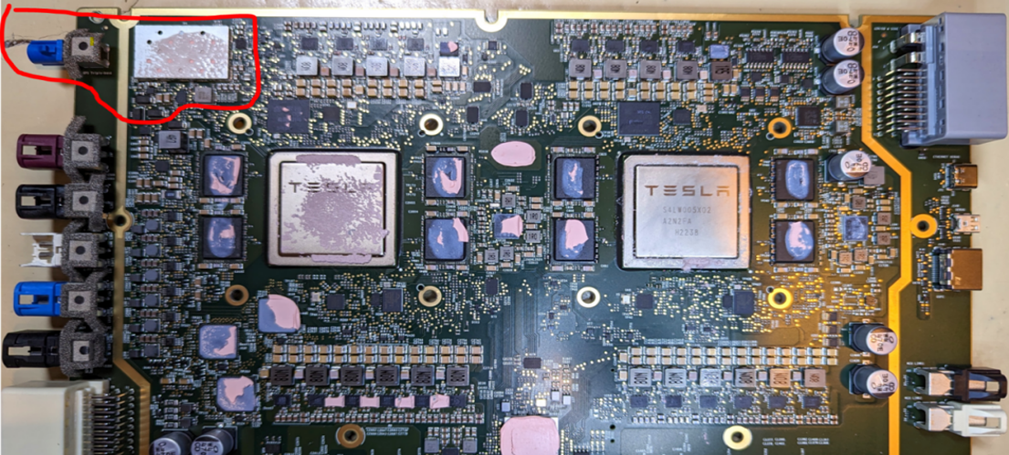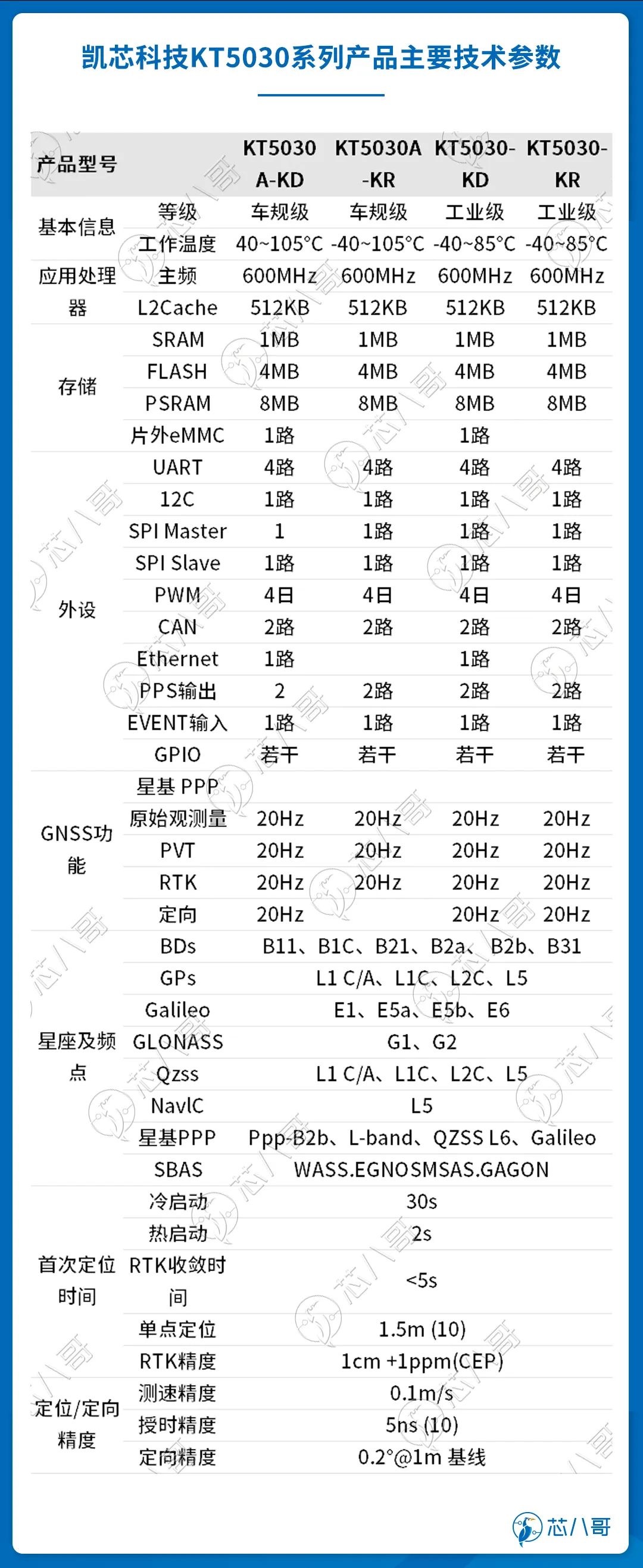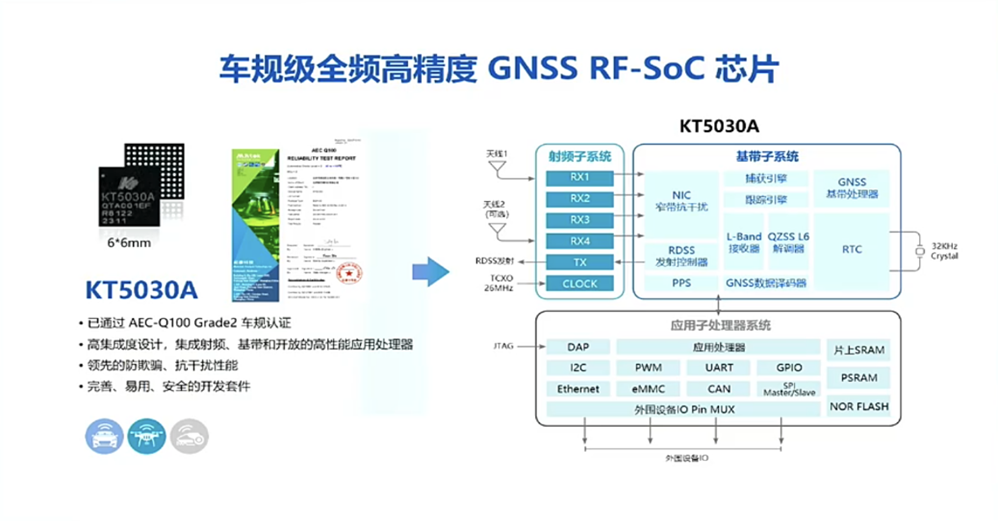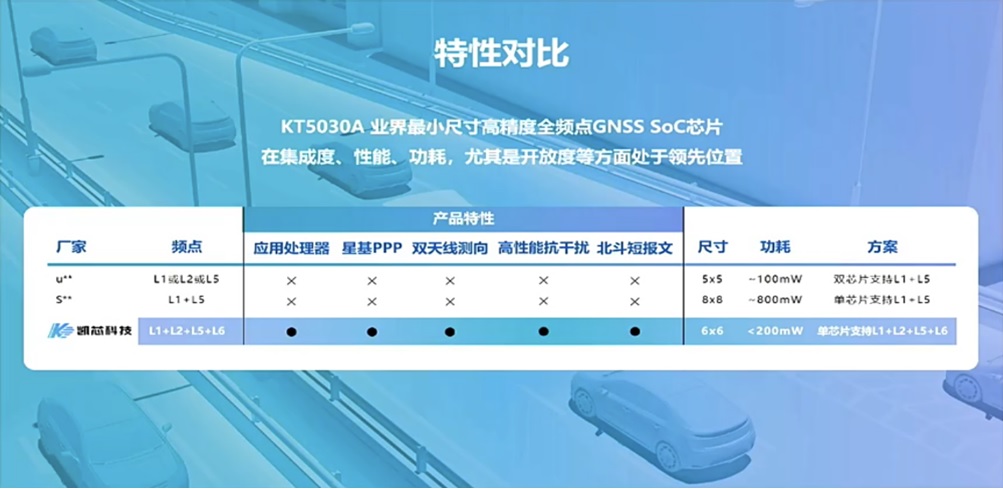Benchmarking against ST, this domestic manufacturer‘s chips of this type accelerate the launch of vehicles
Time:2024-03-03
Views:221
Source: Octopus Core Author: Joey
High precision positioning chips are essential for intelligent terminals to perceive absolute positions, with high entry barriers and wide applications.
High precision positioning chips are expected to explode
In recent years, with the large-scale popularization of high-precision applications represented by autonomous driving, robots, drones, etc., the demand for high-precision positioning chips has been continuously increasing.
For cars with an autonomous driving level of L2+or above, in addition to a global understanding of road conditions, it is also necessary to determine the exact position of the vehicle in real-time during autonomous driving, which cannot be achieved without high-precision satellite positioning. In addition, in terms of accuracy, the positioning accuracy of autonomous driving also requires achieving lane level (positioning accuracy of decimeters or even centimeters), in order to ensure the safety of the vehicle. Therefore, high-precision GNSS chips are a prerequisite for highly automated and fully autonomous vehicles.
At present, in the global automotive market, OEMs represented by Tesla, NIO, Ideal, Xiaopeng, etc. are focusing on intelligence. These OEMs generally achieve L2+or higher levels of assisted driving hardware configuration, and high-precision GNSS chips or modules are also widely used.
From the perspective of vehicle installation, there has been a significant increase in the number of models equipped with high-precision positioning technology since 2022. Among them, NIO, Xiaopeng, Ideal, Hezhong, Zhonghua Yuntong, and BAIC Jihu have all achieved high-precision positioning as standard across the entire series of new models launched in 2022; Traditional host manufacturers have also significantly accelerated their deployment in this area, such as Great Wall‘s Tank 500, Changan‘s Deep Blue SL03, SAIC‘s Feifan R7, Chery‘s Jetu Dasheng, Cadillac‘s LYRIQ Ruige, etc., all launching different versions of high-precision positioning as standard and optional.
In 2023, Tesla‘s HW4.0 adopted the GPS tri frequency solution with stronger performance and reliability. Due to its significant upgrade in the use of satellite positioning sensors, high-precision positioning chips have further attracted market attention.



Tesla‘s HW4.0 uses a more powerful high-precision positioning chip
Source: Network
Zhang Di, the head of chip products at Kaixin Technology, stated that autonomous driving faces challenges such as harsh weather conditions (limited sensor usage), complex road conditions (variable environmental characteristics that affect sensor operation), and urban driving (narrow roads with high precision requirements). And high-precision positioning chips can provide centimeter level absolute position information, and can also support all-weather positioning, reduce system computing power costs, and provide redundancy capabilities, which is the cornerstone of autonomous driving perception. With the maturity of high-precision positioning chip technology and controllable cost, this type of chip has gradually been applied on a large scale in advanced intelligent driving.

Source: Kaixin Technology
From the perspective of penetration rate, according to data from Zuo Si Auto Research, the annual production and sales of automobiles in China in 2022 are about 20 million units, of which about 6.9 million units (including navigation chips and high-precision chips) are intelligent connected vehicles (equipped with L2 level and above driving assistance functions), with a penetration rate of 35%. In terms of assembly rate, from January to October 2022, the high-precision positioning installation volume of mass-produced passenger cars in China has exceeded 280000 units, with an assembly rate of about 1.8%. Based on the above data, it can be inferred that there will be approximately 360000 vehicles using high-precision positioning technology in the intelligent connected vehicles for the whole year of 2022; In 2023, with the further evolution of autonomous driving, the penetration rate of high-precision positioning related vehicles has increased significantly. In the future, with the continuous maturity of technology, it is expected that vehicles using high-precision positioning technology will experience exponential growth.
In terms of competitive landscape, currently high-precision positioning chips, especially in the automotive field, are mainly monopolized by two overseas companies, ST (STMicroelectronics) and U-Blox (Ubeiluo). In the domestic market, manufacturers such as Ziguang Zhanrui, Beidou Xingtong, and Botong Integration are still in their early stages.
From the perspective of development characteristics, u-blox and ST are world-renowned navigation chip manufacturers. Before the launch of intelligent assisted driving, they mainly provided in car navigation positioning chips to various host manufacturers, and have a good customer base. At present, these two companies have iterated their products according to user needs, launched high-precision positioning chips and modules, and widely used them; Meanwhile, domestic high-precision chip manufacturers are gradually reducing costs, volume, and power consumption to meet the needs of large-scale applications. Therefore, in the autonomous driving market, it is a significant opportunity for current manufacturers.
It is worth noting that although many manufacturers are currently laying out high-precision positioning chips, there are still very few companies in the industry that have truly done well.
Zhang Di pointed out that positioning perception is currently one of the core focuses of intelligence in the automotive field, which directly affects the driving safety of cars. Therefore, in terms of technology, there are high requirements for the accuracy, availability, functional safety, information security, and quality stability of perception chips. In the practical application of autonomous driving, there are still many pain points in the current market for high-precision positioning chips, such as various long tail scenarios encountered in NOA systems, as well as satellite observation quality, anti-interference, anti deception, and other issues that high-precision positioning is concerned about in intelligent driving applications, which are all urgent problems that chip manufacturers need to solve.



High precision positioning chips benchmark against leading companies such as ST
As a high-tech enterprise engaged in the independent design and research and development of high-precision positioning chips, Kaixin Technology was established in 2021. After continuous efforts, the company has successfully completed the flow and mass production of multiple advanced process chips, and has gained cooperation and recognition from multiple leading enterprises.
Zhang Di pointed out that high-precision positioning plays a very important role in autonomous driving applications. Based on the commonly existing positioning performance, safety, and reliability issues in the industry, Kaixin Technology‘s newly launched high-precision positioning chip KT5030A has made new explorations in original observation, open high-performance processor platform, functional safety, safety strategies, anti-interference, anti deception, and other aspects, Can effectively improve the security and accuracy of NOA systems.

Source: Kaixin Technology
Specifically, the KT5030A series high-precision chip is a vehicle grade, all constellation, all frequency point GNSS RF SoC chip independently developed by Kaixin Technology. The chip adopts a 22nm advanced process, is equipped with a high-performance multi-core CPU of 600MHz or above, is equipped with dual precision floating-point processing, supports 8MB high-speed data storage, integrates four high-performance RF broadband receiving units, and includes 1040 tracking and demodulation integrated channels. It can simultaneously perform pseudorange, carrier measurement, and navigation message demodulation on all frequency signals of visible satellites.
Although Kaixin Technology is a relatively young company, our technical team is very experienced in both SoC chip design and high-precision positioning. KT5030A is the culmination of the company‘s technology, providing excellent positioning performance not only in complex scenarios such as urban canyons, tree lined roads, and elevated bridges, but also in terms of functional safety, KT5030A can provide redundant original observation output solutions. In addition, in addition to the professional GNSS receiving and measurement engine, we also have internationally leading frequency signal support capabilities, which can simultaneously support both RNSS and RDSS positioning and BeiDou short message communication functions; For satellite based enhancement services, we have also integrated dedicated enhancement channels for L-Band and QZSS L6, combined with high-performance signal reception channels, supporting all satellite based enhancement signals for L-Band, PPP-B2b, E6 HAS, and QZSS L6. At present, the customer has implemented many applications based on KT5030A, covering multiple fields such as autonomous driving, intelligent robots, and drones.
Zhang Di said.

Source: Kaixin Technology
For the high-precision positioning market, currently ublox‘s representative product is the F9K high-precision GNSS module, while ST‘s representative product is the STA9100/STA8100 multi frequency GNSS chip.
As a leading enterprise in the industry, u-blox‘s high-precision positioning chip has been in use on Tesla HW3.0 since 2019. However, due to the use of the GNSS L1 single frequency satellite positioning sensor scheme at that time, the positioning accuracy remained at a relatively rough level of about 2m, and it was often unable to locate due to interference with the GNSS L1 frequency point. In the subsequent HW4.0 products, u-blox carried out a series of optimization on related products, significantly improving the performance, safety and reliability of the auto drive system scheme; The STMicroelectronics P-BOX system solution is based on the system architecture of ST multi frequency and multi constellation GNSS chip (STA9100/STA8100), positioning engine (STA1835), IMU inertial sensor (ASM330LHB), and power management system (LDO DC-DC L5965). It can achieve lane level positioning in various complex scenarios such as underground garages, shaded roads, urban canyons, overpasses, and tunnels, with an error of less than 20cm.
As a startup, Kaixin Technology‘s first product directly benchmarks against industry leaders u-blox and ST, and even many technical indicators and functions are far superior to these two manufacturers.

Comparison between Kaixin Technology KT5030A and its competitors
Source: Kaixin Technology
When discussing the company‘s competitive advantage in the market, Zhang Di stated that KT5030A is the industry‘s smallest size high-precision full frequency GNSS SoC chip. It not only leads the industry in terms of integration, power consumption, openness, etc., but also has significant advantages in positioning performance and anti-interference ability. Specifically, compared to u-blox and ST, the company‘s FIX rate in complex scenes on tree lined roads is as high as 97%, far higher than u-blox‘s 80% and ST‘s 81%. However, in terms of positioning error, the company‘s product is only 0.12m, far lower than u-blox‘s 0.14m and ST‘s 0.15m; In terms of anti-interference performance, in the L1 and L5 frequency bands, the company‘s KT5030A product only showed a decrease of 3.75/3.65 in performance after being interfered with, while the u blox and ST showed a decrease of 6.97/6.66 and 7.97/7.52, respectively. Therefore, compared to its competitors, Kaixin Technology‘s products have stronger anti-interference ability and can effectively resist the impact of high-intensity interference signals of 75dBc. Of course, in addition to the aforementioned advantages, the company also has a comprehensive application authentication and encryption solution, as well as the ability to provide a powerful application processor platform and a complete SDK development kit. We believe that KT5030A will definitely bring new vitality to industry applications.
At present, the level of autonomous driving is evolving from L2 (assisted driving) to L3 (conditional autonomous driving) and L4 (highly autonomous driving).
The higher the level of autonomous driving, the higher the requirements for positioning accuracy, reliability, and functional safety. Therefore, high-precision combination positioning technology will continue to develop in the field of autonomous driving in the future, and high-precision GNSS chips/modules will be widely used in autonomous driving vehicles.
As a high-tech company that converts scientific and technological achievements from Tsinghua University, Kaixin Technology has been committed to providing a precise, reliable, and open multi-dimensional positioning technology platform since its establishment, focusing on the research and development of an open automotive grade high-performance computing chip platform. In the future, Kaixin Technology will be based on KT5030A and work together with partners to achieve a wide range of application scenarios, striving to become a leading global spatiotemporal perception technology enterprise.
|
Disclaimer: This article is transferred from other platforms and does not represent the views and positions of this site. If there is any infringement or objection, please contact us to delete it. thank you! |











